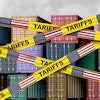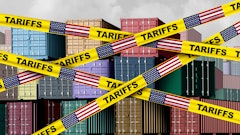
News Flash: Supply chains are highly vulnerable to geopolitical risks.
Trade wars, regulatory changes and political shifts in power can disrupt the flow of goods, impact costs and create significant delays, which in turn influence the reliability and profitability of global supply chains. Companies across all industries are seeking ways to safeguard their operations from these risks and transparency coupled with data-driven insights are emerging as essential tools in this endeavor.
Michael McAdoo, partner and director, Global Trade & Investment, at Boston Consulting Group (BCG), says in terms of direct strains, these geopolitical strains usually occur when trade is slowed between a specific pair of countries, normally driven by geopolitical or economic tensions. These can also be positive effects between country-pairs or trade blocs, such as new trade agreements which can also reshape global supply chains.
"In addition, we see geopolitical conflicts indirectly impact global supply chains – some key examples include the ongoing conflict in Russia and Ukraine, or the Houthi activity in the Red Sea, which have been disrupting global supply chains for many months. The key differentiator is that these indirect strains are not policy-driven, whereas the direct strains can often be linked back to specific policies, such as trade barriers or new trade agreements," says McAdoo.
Businesses asses their level of geopolitical risk in a myriad of ways. Marc Gilbert, global leader of BCG’s Center for Geopolitics and managing director & senior partner, describes two options leaders can consider when assessing their level of geopolitical risk:
- Bringing in an ‘expert’ voice, who can consult with the board and executive team on reframing their strategic planning, capital planning, investment decisions, and so forth, to address geopolitical risk.
- Building out a comprehensive internal team that works to sense, detect and collect relevant information to better foresee and respond to geopolitical events. This team uses specific scenarios which they manage against; for each scenario, they have defined trigger points and modeling capabilities which can measure the level of risk they are facing.
"When it comes to assessing individual levels of risk, there are a few factors companies should consider, including: where do you source, where do you transform, where do you distribute or sell your product, and importantly, which regions are facing the most risk right now? The risk assessment options outlined above can help companies determine where they stand in each realm," says McAdoo.
So, what do we do about it? To avoid future supply chain strain, McAdoo says, companies must evaluate the current geopolitical constraints and what future constraints could potentially look like – they must think beyond what is happening today and anticipate what might happen tomorrow and how they can be best prepared.
"Companies must be practical – avoiding these risks may require more working capital and could be a costly process," explains Gilbert. "Realistically, expanding the facilities and suppliers in your supply chain will be more expensive in the short run, but it does effectively reduce concentration risk, creating a more resilient, dependable supply chain, protecting future revenues and profits."
In an era of data, we've seen the impact of transparency in supply chain risk mitigation. Gilbert says having data on their supply chains does not innately allow companies to lower risk levels, but it does enable them to act and manage risks. A company can have all the information in the world and be inactive; companies need to take both proactive and reactive actions in the face of risk – whether this means shifting their supply base, changing their manufacturing or assembly locations, etc. It is all about taking action, explains Gilbert.
"Supply chain transparency is critical as this is how companies can find out where the risks lie. For many companies, this isn’t difficult from a first order perspective – they know where their primary supplier's source and ship from, but the real challenge is with second and third order suppliers," says McAdoo. "For example, a company may be buying a product which has a final assembly in a benign location, but the supplier themselves may have supply chain touchpoints in areas that are more geopolitically risky. The biggest difficulty is identifying these types of upstream risks."
In a world where geopolitical risks are becoming more frequent, companies that prioritize supply chain transparency and leverage data effectively are better positioned to adapt, reduce costs and protect their reputations.




















